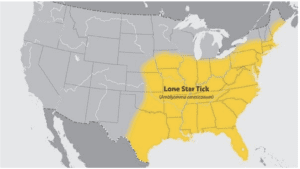As an arborist in Connecticut ticks are just another job hazard to be prepared for. I wanted to share some strategies and precautions used to identify the hot spots and avoid the bite. While there has been much acknowledgment of the ever-growing problems and continuing research on the viruses, infections and diseases carried and spread by these yard prowlers. I’ve recentIy been a lot more aware of viruses as I’m sure everyone has. I wanted to update this article in hopes of bringing attention to the opportunity for additional therapies and better drugs for the wide array of these terrible sicknesses. See the photo illustrating the range of the Lone Star Tick and the Heartland Virus that it carries.
I feel there has been less information on why and how these pests are so prevalent in some areas.
I will leave the statistics and medical info surrounding this subject to experts in those fields. My intent is for people to be better prepared and change some things that matter in an effort to protect their health and way of life.

Let us start with your own home and yard. In Connecticut ticks rely on a host to survive the winter. People associate deer as the worst host for carrying ticks. While deer are a major host, the White Footed Mouse is actually the reason for ticks being so wide spread. This habitat being so close to our everyday life is why there are so many problems associated with this parasite. Ticks infest these mice that are nesting in various areas around your house, brush and wood piles, gardens, stonewalls. The most important hot spot, leaf litter / wood line areas where your lawn meets the woods. The most effective thing a homeowner can do is eliminate mouse habitat in order to decrease the amount of ticks in your yard. A best practice is to develop an eco-tone area between the woods and your lawn where ticks can’t survive. Wood chips / mulch spread as ground cover in an area at least 15’ wide. Maintaining this area will give you results while keeping your pets out of the woods as well. Also don’t blow your leaves into these wood line areas creating the mouse habitat. After this I suggest you treat any other mouse habitat areas.
A very effective means of treatment I use is actually geared toward using this host to help kill ticks. TickTubes are deployed all year round in these mouse habitat areas around your yard. These cardboard tubes are filled with Permethrin treated cotton balls. Mice can’t resist adding them to their nests. The treated cotton balls kill the ticks and stop the life cycle of the ticks. This is a very green and safe means of protecting your yard and family. Winter is actually a great time for this style treatment.
Outdoor adventures such as hikers, joggers, hunters and fisherman can better enjoy themselves by using the Permethrin insecticides to treat their clothes as it lasts up to six weeks or six washes. Also using a spray on application of DEET contained insecticide on your most exposed skin is recommended. You might be squeamish about these products and I don’t blame you however contracting one of the various diseases and or infections associated with a tick bite is a much worse outcome then these pesticides which are being called safe these days.
